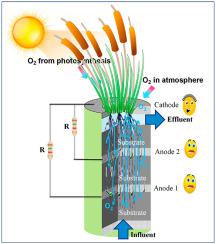Chemosphere ( IF 8.1 ) Pub Date : 2020-09-16 , DOI: 10.1016/j.chemosphere.2020.128354 Yan Yang , Yaqian Zhao , Cheng Tang , Ranbin Liu , Tianhu Chen

|
In the recent years many studies have shown that wetland plants play beneficial roles in bioelectricity enhancement in constructed wetland-microbial fuel cell (CW-MFC) because of the exudation of root oxygen and root exudates. In this study, the long-term roles of plants on the bioelectricity generation and contaminant removal were investigated in multi-anode (Anode1 and Anode2) and single cathode CW-MFCs. The electrode distances were 20 cm between Anode1-cathode and 10 cm between Anode2-cathode, respectively. Additionally, the employment of natural conductive pyrrhotite mineral as cathode material was firstly investigated in CW-MFC system. A cathode potential of -98±52 mV to -175±60 mV was achieved in the unplanted (CW-MFC 1), and planted CW-MFCs with Iris pseudacorus (CW-MFC 2), Lythrum salicaria (CW-MFC 3), and Phragmites australis (CW-MFC 4). The maximum power densities of Anode1-cathode and Anode 2-cathode were 8.23 and 15.29 mW/m2 in CW-MFC 1, 8.51 and 1.67 mW/m2 in CW-MFC 2, 5.67 and 3.15 mW/m2 in CW-MFC 3, and 7.59 and 14.71 mW/m2 in CW-MFC 4, respectively. Interestingly, smaller power density was observed at Anode2-cathode, which has shorter electrode distance than Anode1-cathode in both CW-MFC 2 and CW-MFC 3, which indicates the negative role of oxygen released from the flourished plant roots at Anode2 micro-environment in power production. Therefore, recovering power from commercial CW-MFCs with flourished plants will be a challenge. The contradiction between keeping short electrode distance and avoiding the interference from plant roots to maintain anaerobic anode may be solved by the proposed modular CW-MFCs.
中文翻译:

以黄铁矿为正极材料的大型植物在人工湿地微生物燃料电池中的双重作用:比较评估
近年来,许多研究表明,由于根氧和根系分泌物的渗出,湿地植物在人工湿地微生物燃料电池(CW-MFC)的生物电增强中起着有益的作用。在这项研究中,在多阳极(Anode1和Anode2)和单阴极CW-MFC中研究了植物在生物电产生和污染物去除方面的长期作用。阳极之间的电极距离为20厘米,阳极之间的电极距离为10厘米。另外,首先在CW-MFC系统中研究了使用天然导电黄铁矿矿物作为阴极材料。在未种植的(CW-MFC 1)和种植有鸢尾鸢尾(CW-MFC 2)的CW-MFC中,阴极电位达到-98±52 mV至-175±60 mV 。千屈菜(CW-MFC 3)和芦苇(CW-MFC 4)。Anode1-阴极和阳极2-阴极的最大功率密度为8.23和15.29毫瓦/米2在CW-MFC 1,8.51和1.67毫瓦/米2在CW-MFC 2,5.67和3.15毫瓦/米2的CW- MFC 3、7.59和14.71 mW / m 2分别在CW-MFC 4中。有趣的是,在Anode2阴极观察到较小的功率密度,在CW-MFC 2和CW-MFC 3中电极距离都比Anode1阴极短,这表明从Anode2微电极上蓬勃的植物根部释放的氧气具有负作用。电力生产的环境。因此,从植物繁茂的商用CW-MFCs中恢复能量将是一个挑战。所提出的模块化CW-MFCs可以解决保持电极距离短与避免植物根系干扰维持厌氧阳极之间的矛盾。











































 京公网安备 11010802027423号
京公网安备 11010802027423号